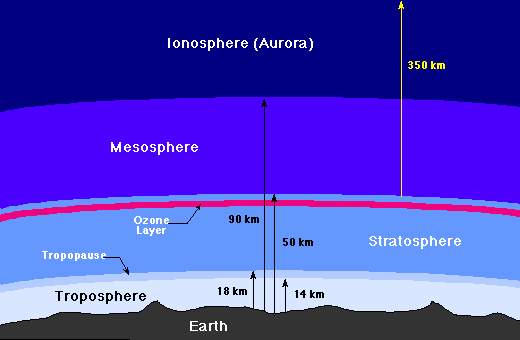



|
Without our atmosphere, life as we know it would not exist. Apart from providing the oxygen we breath, it filters out most of the harmful Solar radiation, and acts like a giant thermostat, maintaining the planets temperature within tolerable levels. To compare this to an airless body, we only need to look in our own backyard - the Moon's temperature fluctuates between an average of 120 degrees C (250 degrees F) during the day to -170 degrees C (- 275 degrees F) at night. A carbon based life-form such as ourselves could not survive such extremes. When the Earth receives (light and ultraviolet) energy from the Sun, much of it is absorbed either by the atmosphere or at the Earth's surface. The Earth re-radiates (infrared) energy back to space, such that there is a balance between incoming energy from the Sun and outgoing energy from the Earth. This global energy balance maintains a fairly even temperature at the surface of the Earth. Of course, there are differences in temperature between different parts of the world, due to the different amounts of received sunlight. Regions nearer the equator receive much more energy than regions nearer the poles, and are consequently much warmer. These differences in surface temperature create flows of energy within the Earth's atmosphere itself, which are the driving forces behind the world's weather.
|
|
|
|
Troposphere
|
|
Height variable (Season & Latitude) Ground level to 16km (10 miles) at the equator and to 9km (5 miles) at the North and South poles. This first layer of the atmosphere, the troposphere is separated from the stratosphere by a band of stable temperature called the tropopause. Changing conditions within the troposphere creates what we call weather. The temperature declines as the altitude increases from the valleys up to the tops of the mountains. The convection of the warm air rising from the surface and mixing with the cold air in the upper area of the layer, causes the formation of clouds, rain and wind currents, all giving rise to our weather. Because of the weight from the other layers pressing down, the troposphere is the most densly packed of all the layers. It contains almost 75% of the total mass of the atmosphere, and almost all the water vapour is in this layer.
|
|
Stratosphere
|
|
Height up to 50km (30 miles) [Contains the Ozone Layer between 15-40km (10-25 miles) ] The temperature of the stratosphere (strato meaning stratification - layers ) is around -55C (-67F) in the lower level and rises with increasing altitude, reaching 0C in the higher, very thin air. This high temperature is due to the oxygen and the ozone layer, which although only having a concentration of 12 ppm (parts per million) does an excellent job in absorbing the ultra violet radiation from the sun. Due to this inversion layered effect, there is hardly any vertical convection, giving very stable atmospheric conditions.There is an almost total lack of clouds, and none of the air turbulence experienced in the troposphere. All of these conditions make this an ideal altitude for passenger jet flight. The upper level of the stratosphere carries the jet-streams, horizontal winds of up to 480km/hr (300mph)
|
|
Mesosphere
|
|
Height up to 100km (65 miles) The mesosphere (middle sphere) is the third layer, but unlike the stratosphere, the heat in this layer rapidly decreases with increasing altitude, down to around -100deg C. This layer is not only the coldest of all the atmospheric layers, it is even colder that antarctica. This is the layer in which comets that enter the earths atmosphere burn up, giving us such an evocative sight.
|
|
Ionosphere |
|
Height above 100km (65 miles) The ionosphere is a layer of ionized air in the atmosphere extending
from almost 80 km above the Earth's surface altitudes of 600 km and
more. Technically, the ionosphere is not another atmospheric layer.
It occupies the same region of the upper atmosphere as the thermosphere.
In this region of the atmosphere the Sun's energy is so strong that
it breaks apart molecules and atoms of air, leaving ions (atoms with
missing electrons) and free-floating electrons. The ionosphere is the
region of the atmosphere where the Aurora Borealis and Aurora Australis
(the Northern and Southern Lights) occur.
|
|
Exosphere
|
|
Not shown in the above graphic is the Exosphere The exosphere is the most distant atmospheric region from the Earth's surface. The exosphere is a transitional zone between Earth's atmosphere and interplanetary space. The exosphere is defined as the atmospheric region where the number of collisions between particles are negligible. The atoms follow different kinds of free-space trajectories and some of them can escape from the terrestrial atmosphere. The kinetic temperature loses its ordinary meaning and the hydrostatic law is no more valid. The critical level corresponding to the base of the exosphere is called "exobase" and is located between 350 and 800 km depending on the temperature at the thermopause. Helium and hydrogen are the major exospheric constituents. The hydrogen atoms constitutes the corona of the atmosphere.
|
 |
 |
|
"Have you ever wanted to
know why it is that 'hot air rises' and'cold air sinks', but the higher
you go the colder the air gets?" |
![]()
|
Office
|
Quiz
|
![]()